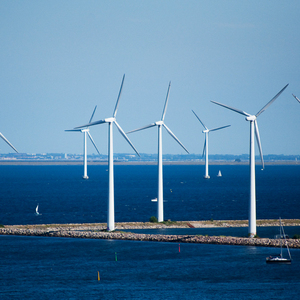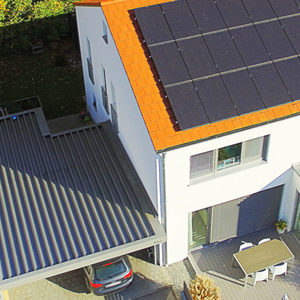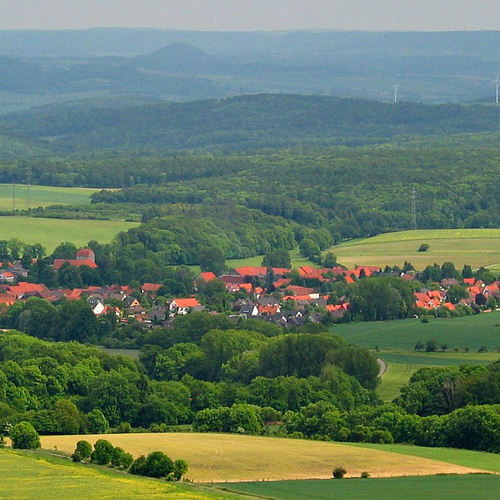
This post originally appeared at Yale Environment 360.
Northern Germany, from the Polish borderlands in the east to the Netherlands in the west, is the stronghold of Germany’s muscular onshore wind power industry. This is where the lion’s share of the country’s nearly 30,000 wind turbines are sited, a combined force equal to the power generation of about 10 nuclear reactors. Where Germany’s northernmost tip abuts Denmark, soaring turbines crowd the horizon as far as the eye can see. And many more are coming as Germany strives to go carbon neutral by 2050.
Yet despite their impressive might, the north’s wind parks are a reminder not only of how much has been accomplished in Germany’s Energiewende, or clean energy transition, but also of what remains to be done. The country has made a Herculean effort to shift to a clean energy economy. In just the past five years, government support and costs to consumers have totaled an estimated 160 billion euros ($181 billion). But Germany’s greenhouse gas emissions have not declined as rapidly as expected in response to the vigorous expansion of renewable energy, which now generates 40% of the country’s electricity. Germany’s politicians are even resigned to falling significantly short of the country’s 2020 goal of reducing emissions by 40% below 1990 levels.
Germany’s failings have come as a vexing shock to its environmentally conscious citizenry. While Germans still overwhelmingly back the energy transition — for years polls showed support in excess of 90% — about three-quarters say the government is not doing enough to slow global warming.
Today, the Energiewende finds itself stalled and floundering. Germany’s carbon emissions have stagnated at roughly their 2009 level. The country remains Europe’s largest producer and burner of coal, which generates more than one-third of Germany’s power supply. Moreover, emissions in the transportation sector have shot up by 20% since 1995 and are rising with no end in sight, experts say. German consumers have seen their electricity bills soar since 2000, in part because of the renewable energy surcharge.
Now, complex, discomfiting questions loom about the way forward if Germany is to meet even its minimal targets and play the nation’s part in putting the brakes on global warming. From green groups on the left, to independent think tanks, to industry associations, experts have put forth numerous plans to regain the momentum of the Energiewende and decarbonize Germany’s economy.
The issue is urgent: The German Energy Agency (DENA), a think tank supported by public and private funds, found that if the country continues along its present course, carbon emissions will fall by only 62% by 2050 — well short of the government’s goal of slashing emissions up to 95% below 1990 levels by mid-century. And analysts say that the challenges Germany now faces will confront other industrialized societies as they attempt to wean themselves off fossil fuels.
The effort began as a grassroots campaign
The Energiewende began as a bottom-up movement that took off in 2000 when grassroots campaigns persuaded legislators to support renewable energy expansion through feed-in tariffs. In the aftermath of the Fukushima nuclear disaster in Japan in 2011, Chancellor Angela Merkel and her government got behind the energy transition and drafted blueprints to guide it.
But in recent years, the government, in the face of auto industry opposition, backed off decarbonizing the transportation sector; has not supported a significant price on carbon; has dragged its feet on grid expansion; has declined to set a date for phasing out coal; and has not implemented significant parts of its own 2050 climate program. Some analysts say that Merkel’s decision to step down in 2021 could be a boon for the Energiewende, as the Green Party is rising in the polls and will likely play an important role in the next government.
Against this backdrop, the German government’s Climate Protection Program 2050, the Energiewende’s current road map, has come under a barrage of criticism. “The goals set in the climate program aren’t nearly ambitious enough,” says Benno Hain of the Federal Environment Agency, referring to its vague aim of reducing emissions by 80% to 95% compared to 1990 levels. Germany must shoot for a 95% reduction and nothing less, Hain says, which means new big-picture scenarios and greater rigor in implementing them.
Tanja Gaudian, of the renewable energy utility EWS Schönau, argues that Germany is sorely in need of a new energy transition master plan. “It’s not even clear whether this Energiewende will continue to be one driven from below, by communities and citizens as it has so far, or whether the big utilities will be given a special role, even though they don’t deserve it,” she says, referring to their decades-long opposition to renewable energy. “There’s so much that’s up in the air.”
Technological “miracles” won’t be necessary
The government’s 2050 program, however, is not the only game plan in town for going climate-neutral. German industry, high-level research institutes, NGOs, and think tanks such as DENA have invested heavily in sophisticated analyses that sketch out alternative scenarios for decarbonizing Germany’s energy system. These scenarios address the nature of the technologies of the future; whether coal and other fossil fuels should be forced out of the energy supply or simply left to wither away through market forces; the role of synthetic fuels and hydrogen, as well as carbon capture and storage (CCS); and the extent and type of domestic renewable energy generation. All of these questions are complicated further by the ongoing phase-out of nuclear power, which is not contested in Germany.The major studies — even those conducted with involvement from Germany industry — concur that Germany can hit its 2030 targets if it changes course. At the very least, these pilot studies can inject new ideas into Germany’s energy policy debates.
“These scenarios show that Germany’s climate and energy targets can be reached with current technologies and without breaking the bank,” says Toby Couture of the think tank E3 Analytics in Berlin. “We don’t have to pull rabbits out of hats or hope for technological miracles. There are two basic things needed to achieve these ambitious decarbonization goals: political will and investment certainty. In the early 2000s, Germany had both; now it arguably has neither.”
Not surprisingly, green organizations and parties — including Greenpeace, Environmental Action Germany, Friends of the Earth Germany, and the German Greens and the Left Party — are calling for a more rapid expansion of renewable energies, a quicker legislated end to coal generation, and the full-scale revamping of Germany’s transportation sector.
Greenpeace Germany has authored one of the most extensive models, which starts with the lofty premise that a 100% elimination of greenhouse gases (compared to 1990 levels) is possible in 30 years. Key to this scenario is that Germany can, and should, stop burning coal by 2030. Under this plan, the oldest and dirtiest coal-fired plants, one-third of Germany’s fleet, would have to shut down by 2020. Another third would close five years later, and the rest in 2030. Greenpeace calls for a steep carbon-pricing scheme that rises to 40 euros a ton by 2030. (The EU’s carbon-trading scheme currently lists a ton of carbon at 12 euros.)
Wind and solar would bridge the gap
The energy generation capacity lost by removing coal and nuclear power from the supply would be made up for primarily by renewables, argues Greenpeace — above all offshore wind, which is still in its early stages in Germany. While the massive rollout of offshore wind power — more than 12 times the current fleet of 1,170 turbines — is the central plank of Greenpeace’s strategy, it also calls for a tripling of onshore wind generation and five times the photovoltaic capacity.
In the interim, Greenpeace acknowledges that renewables would probably have to be aided by natural gas-fired generation. These ambitious goals would be achievable, argues Greenpeace, by reducing demand: dramatic energy efficiency measures could slash demand for electricity by 18% and for heat by 46% compared to 2012 levels.
Moreover, decarbonizing the transportation sector by 2030 implies not only accelerating the transition to electric vehicles, but phasing out conventional, gasoline-powered cars between 2025 and 2035, Greenpeace says.
“It’s definitely feasible to ramp down coal by 2030,” says Jörg Mühlenhoff of the Agency for Renewable Energies, a Berlin-based renewables advocacy organization.
Indeed, Mühlenhoff says that if a carbon price hits 30 euros, that would effectively spell the end of coal. He adds that renewables could cover most of the gap left by coal if the German government introduces new policy initiatives to spur investments in green energy.
Until quite recently, most of Germany’s industrial sectors, particularly the more energy-intensive among them, had treated Energiewende with acute skepticism. They worried that high energy costs and supply bottlenecks would hurt their competitive edge in international export markets. Yet German industry is becoming more deeply involved in the Energiewende, given the demand for the likes of renewable energy infrastructure (think wind turbines, manufactured by Siemens), electric vehicles, and other green energy technologies. Industry now believes it’s better to jump on the bandwagon and engage in policy discussions rather than carp from the sidelines.
Earlier this year, for example, a call for government action signed by 50 prominent businesses — including Siemens and the electronics and construction industries — insisted that “Germany needs a robust strategy for implementing its comparatively stringent emission reduction targets if it does not want to fall behind in the global race to develop carbon-neutral economies.”
This turnaround is nowhere more evident than in the pilot study of the Federation of German Industries (BDI), Germany’s largest and most powerful industrial lobby organization. In close collaboration with German businesses, BDI has modeled several Energiewende scenarios that are unapologetically pro-business and pro-industry, yet support the broader goals of the energy transition.
“The remarkable thing about the BDI study is that German industry is saying that the Energiewende is technically and economically feasible by 2050,” says Cyril Stephanos of Germany’s National Academy of Science and Engineering, which runs an Energy Systems of the Future program. “It shows that there’s money to be made and not just for industry but for the entire economy.”
A need for an international consensus
The BDI study, however, underscores that unless there’s a multilateral international consensus about targets, burden sharing, and tools like a global CO2 price, Germany should shoot for reducing emissions by only 80% below 1990 levels by 2050. The study claims that, when factoring in savings accrued by dropping fossil fuels from the supply, Germany could reach that target at an additional cost of 240 billion euros, while reducing emissions by a full 95% would cost the country 500 billion euros.
This BDI scenario relies strongly on energy efficiency, especially in the housing and building sectors, where the chemical industry has much to gain from retrofitting older buildings and providing new buildings with state-of-the-art insulation. It calls for doubling the rate of retrofitting housing and urges requirements that all new homes essentially be highly energy-efficient “passive houses.”
A third approach to fixing the Energiewende combines a rigorous reduction of emissions (95% by 2050) with solutions that appeal to German business. The research institute DENA favors a rollout of sun- and wind-based renewables, but also advocates for a broader mix of technologies that includes a high volume of synthetic fuels.
Both the DENA and BDI scenarios also depend on carbon capture and storage (CCS) in the transition’s final phase, when energy intensive industries will have to be decarbonized. “We ran our modeling through several times,” explains Christoph Jugel, head of DENA’s energy systems analysis unit. “And even using other technologies we couldn’t manage to eliminate the last 16 million tons of CO2 left without CCS.” But Jugel notes that the different scenarios don’t factor in technological breakthroughs that can, and most probably will, happen in the decades ahead.
Stephanos says the studies show that Germany will need anywhere from four to seven times as much wind and solar power as it has now. “All of the studies mention about 5 to 10 million electric cars by 2030,” notes Stephanos. “We’re ramping up, which is good, but we’re not yet close to even a million. There’s still a lot left to figure out. We don’t even know if electricity, hydrogen fuel cells, or biofuels are the best way to decarbonize transportation. It’s astonishing how much more Germany has to do.”
Paul Hockenos is a Berlin-based writer whose work has appeared in The Nation, Foreign Policy, The New York Times, and The Atlantic.
Weekly Newsletter
Get building science and energy efficiency advice, plus special offers, in your inbox.
















8 Comments
So $181 biliion to get to 40% of 654,000 gigawatts would be $452 billion to get to 100% if it were all linear but offshore production is probably 3 times as expensive as on shore. Anywho, the US produces 4,282,000 gigawatts roughly 6.6 times Germany. I suppose we can expect about 2.97 TRILLION in cost for the US.
> expect about 2.97 TRILLION in cost for the US.
Less than the cost of a couple of recent wars.
Which we'll never pay ($) for.
>Greenpeace Germany has authored one of the most extensive models, which starts with the lofty premise that a 100% elimination of greenhouse gases (compared to 1990 levels) is possible in 30 years.
Compared to 1990 levels? That's odd- 100% reduction would mean 100%, no matter what the reference year level was, eh? Why 1990? Why not 1890, or 2017, or 1790? 100% is 100% and 100% elimination is zero, at any basis year.
>"So $181 biliion to get to 40% of 654,000 gigawatts would be $452 billion to get to 100% if it were all linear but offshore production is probably 3 times as expensive as on shore. Anywho, the US produces 4,282,000 gigawatts roughly 6.6 times Germany. I suppose we can expect about 2.97 TRILLION in cost for the US."
Bad math.
First it is never linear- there is a significant "learning curve" with production as manufacturing volumes ramp up. The learning curves for solar, wind, and batteries are all still in double-digit percentage cost reductions per doubling of volume.
But the bigger factor is that US wind resource and solar resources are much richer and easier to develop than Germany's and all else being equal (which it isn't) should be much MUCH cheaper to develop. How much cheaper it actually works out to be remains to be seen. But a terawatt-hour of German onshore wind is pretty expensive given the tepid capacity factors, and the capacity factors of better-resourced US ONshore wind is comparable to or greater than Germany's OFFshore wind. The projected capacity factors of offshore wind in New England is about .5 x that of a typical Baltic or North Sea offshore wind farm, so even at the same hardware cost the cost per delivered terawatt hour will be lower, even without discounting for learning curve cost reductions.
And don't even get be started about PV capacity factors at Germany type latitudes. Move all that PV to Texas and it'll deliver twice the output per panel.
So, 6.6x the terawatt hour volumes, sure, but with learning curves and resource quality factored in maybe 2-3x the cost, not more.
Perhaps they mean a reduction in GHG down to 1990 levels? I suspect the compromise was 1990 because someone in Berlin realized that you can't kill off the goose (ie, economy) which lays the golden eggs and that people actually need power in order to have a life.
Plans change as always and Europe is again facing another recession so that changes things.
>"Perhaps they mean a reduction in GHG down to 1990 levels? "
Doubtful, since they are already about 25% below 1990 emissions levels in Germany:
https://s3.amazonaws.com/greenbuildingadvisor.s3.tauntoncloud.com/app/uploads/2019/01/14103523/Germany-chart.jpg
The 1990 basis year is widely used in international greenhouse gas agreements in targets, but when talking about 100% reduction the basis year doesn't matter, which is why it seems silly to use any basis year when talking about 100%.
There is broad consensus in Germany that it's "worth it" to pay more for power now to be rid of the air pollution and greenhouse gas issue sooner rather than later. But both wind and solar are now cheaper on a lifecycle basis (even without factoring in a cost for global warming) than coal. It's not a sacrifice to make it go away sooner than later unless done in a haphazard manner. The only real competition for renewables on cost in the US for new generation is really combined cycle natural gas, and even that isn't anything like a sure bet.
This is quite a cautionary tale. Germany has long been the leader in distorting energy markets by providing huge subsidies ($2 trillion worth) to some of the least cost-effective ways to reduce carbon emissions. It comes as no big surprise that after spending so much, the country has so little to show for it. Intermittent power from wind turbines and PV are doing far less than those industries claims or than most people think when it comes to reducing carbon emissions. This has been fairly well documented for a while now.
https://www.nytimes.com/2017/11/07/business/climate-carbon-renewables.html?action=click&contentCollection=Energy%20%26%20Environment%20&module=RelatedCoverage®ion=EndOfArticle&pgtype=article
It would be nice if other countries, including our own, could learn from Germany’s very expensive mistakes, but unfortunately, I don’t see it happening -yet.
There is a much better way to go about this; ditch all the subsidies, adequately fund research, and most importantly; implement meaningful carbon tax and dividends. Then let the market do its job.
This is not a new or original idea: 27 Nobel laureates and 4 (all) former Federal Reserve chairs have signed up in support of a carbon-fee-and-dividend plan. https://www.clcouncil.org/economists-statement/
There are endless ways to reduce carbon emissions. The most effective ones involve changes in consumption and lifestyle, others have yet to be invented. But those won’t happen in a meaningful way if we keep on distorting the energy markets thru misguided financial incentives.
> implement meaningful carbon tax and dividends
Agreed, the atmosphere is not a free dumping ground. And stop subsidizing fossil fuels (with wars, etc). Residential scale solar is a example of market distorting waste in the US.
Log in or create an account to post a comment.
Sign up Log in